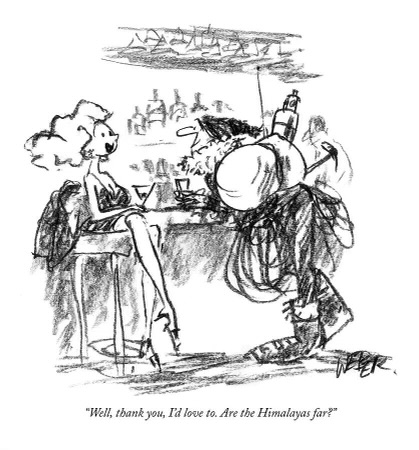Imagine you’re at a trailhead in the wilderness. Sunrise is lightening the eastern sky, birds are singing their dawn song in the tops of the firs, and the creek beside your trail is burbling happily, full of fresh snowmelt, beckoning you upward.
You’re excited to climb to the top of the mountain on the horizon, with the last of the night’s stars fading away behind it. You’ve wanted to climb this mountain for years, and today is the day. You take one last drink of water, shoulder your pack, strap on your hiking poles, and embrace the journey ahead.
But then. A voice. It belongs to a young man emerging from the trees. He wears an official uniform and a badge, and he tells you to stop. “Hold up,” he says. “I’m going to give you some of these before you go.”
He gestures to a table laden with a strange assortment of objects: rocks in ten-pound bags, pairs of shiny red stilettos, rolls of Cling Wrap, and heavy mittens. He tells you to remove your sturdy trail shoes and replace them with the stilettos, puts two bags of rocks in your backpack, and wraps your head in Cling Wrap in which he’s poked tiny holes for your nose and your mouth.
You object, although it’s difficult through the plastic wrapped around your head.
He says, “Sorry, ma’am. This is how it is. I don’t make the rules. Oh. I almost forgot. You have to give me half your food.”
This seems strange to you. You wonder who’s making these rules, but you give the young man most of your lunch and start up the trail.
You’re beginning to wonder if you’ll make it up that mountain.
Thoughts create feelings which lead to actions that accumulate as results. Period.
That’s what I learned in Wayfinder coach training, and it’s what I’ve taught clients myself. The idea is that once we can catch a thought causing suffering, we can do the work to change the thought. Because, thankfully, thoughts, unlike feelings, are changeable. (Changing an action without changing the thought(s) motivating the action is white-knuckling ourselves into a desired state. This “change through brute force” takes lots of will power, a finite resource.)
This black and white, clear cut, linear formulation is the foundation of Cognitive Behavior Therapy (CBT), and it’s been helpful for many.
Well. Turns out it’s not true, that feelings are always, 100%, no exceptions, caused by thoughts. Researchers are finding that what eases suffering isn’t changing the thought, but getting distance from it. Learning to detach from a thought causing suffering is one of the pillars of Acceptance and Commitment Therapy (ACT).
I now have a broader understanding and therefore a more nuanced perspective on thoughts, feelings, and actions.
Thoughtwork is great for thoughts causing suffering. We suffer when we take life’s inevitable pain personally. Thoughtwork used on pain, not suffering, is ineffective and potentially harmful.
That said, “unhelpful thoughts create unhelpful feelings that lead to unhelpful actions” is true often enough that it’s worth having some basic thoughtwork tools in your toolbox to ease your suffering. I’ve been playing around with a new one, and want to share it with you. It’s called “Cruel, Sadistic Operating Instructions.”
Cruel, Sadistic Operating Instructions
I found this one in Carolyn Elliott’s book Existential Kink. (The book has a lot of wacky stuff IMO, but this tool is priceless.) She calls it “How to Beat Yourself Up (the Fun Way).” In Carolyn’s words: “Make your cruel, sadistic ‘operating instructions’ radically explicit.”
Here’s how it goes.
Dig deep and see if you can uncover the real rules you live by—your cruel, sadistic operating instructions.
We find our cruel, sadistic operating instructions when we investigate where we’re suffering. You know what suffering feels like. It feels weighty, stuck, trapped, caged, stagnant, frustrating. Anger that never goes away. Despair that persists. Attempts to control the uncontrollable.
Pain, by contrast, moves through us. Pain ebbs and flows. Pain is alive.
Look where you feel deadness, and you will find your suffering.
Here are some of my cruel, sadistic operating instructions:
I must never, ever, ever expand and grow bigger than my childhood roles and identity.
I must never, ever, ever, create something original—art, writing, a coaching process, a business—because it might be flawed or ugly and therefore unworthy of existence.
The only thoughts that matter are the ones others think or have thought.
I must always listen and never speak.
I must never, ever, ever decide anything for myself. I must never, ever, ever feel exuberant happiness.
I must never, ever, ever do anything I might not get perfect the first time. No mistakes, ever.
And so on.
Now, of course these aren’t true. They’re ridiculous—statements I would never, ever, ever say to my kids or to anyone else. I have managed to expand, create, think for myself, speak up, feel happy, and make decisions.
But doing those things has been harder than they needed to be, because of my buried operating instructions.
Articulating my actual cruel, sadistic operating instructions helps me see how they’re still controlling me.
I’ve been white-knuckling myself past my operating instructions, feeling anxious and guilty when I break them. They’re buried deep.
Like vampires, exposing these rules to the light takes away their power.
Uninstalling the operating instructions that no longer serve me is a skill. And that’s where thoughtwork comes in.
So, what’s going on with you, dear mountain climber?
Well, you’re doing your best to get up that trail with all those impediments. After all, you think, this is how he said it needed to be. I don’t understand, but I don’t have a choice. This must be how everyone does it.
Maybe there’s something wrong with me, that this is so hard.
You walk and you walk and you walk, grinding out step after step in those god-awful shoes, sweat pooling under the Cling Wrap, trying to see through the layers of plastic film, carrying that heavy, heavy backpack.
Until you just can’t anymore. You teeter your way to the creek bank, heels catching on rocks, ankles twisting, and slide down onto the grass. You shrug off your backpack, kick off those ridiculous shoes, rip the Cling Wrap from your head, and put your feet in the water. Cold water flows over your blistered feet, fir-scented breezes cool your sweaty head, your shoulders relax and soften.
A Dipper flies downstream.
You’re tapped out. You’ve hit a wall. You know you can’t go any further, and you so badly wanted to get to the mountain top. You sit, trying to accept your disappointment. Then you notice that the Dipper is in the creek in front of you, watching you. She’s been there for some time, perched on top of a log in the water on the other side of the creek, singing and dipping as Dippers do.
The log is hollow, and inside the log is a box.
You wade toward the log. The Dipper watches your steady progress, bopping up and down encouragingly. You reach the log and pull out the box.
Behind the box, deep in the hollow log, is a pair of sturdy trail shoes, your size, in the color you always wanted but REI was always sold out of. Oh, hell no, you think. I am not wearing those ridiculous stilettos one more goddamn minute. You carry the shoes and the box back across the creek.
Sitting there with your feet in the water, the fir-scented breeze playing with your hair, the sound of the creek in your ears, you open the box. Inside is the food you left with the young man at the trailhead—your turkey sandwich, your bag of Fritos, and your oatmeal cookie.
You’re beginning to believe you can get to the top of the mountain after all.
Why would I keep carrying this stuff?, you think. You pull the bags of rocks out of your backpack and empty them into the creek. You stuff the empty bags, the wad of sweaty Cling Wrap, and your lunch into the backpack, dry your feet, and put on your beautiful new shoes. They feel so good. You return to the trail and resume your journey toward the mountain that is your goal: snow-capped, sturdy, shining in the morning sun. You’re strong. You’re brave. And you’re really looking forward to getting to the top of that mountain.
Those stilettos? They’re swinging jauntily off your backpack by their sparkly straps. You’re not sure yet what you’ll do with them, but you know it’ll be something good.
PS. If you’d like to share your Cruel, Sadistic Operating Instructions, hit reply. Confidentiality guaranteed. You can also tell me what you’ll do with those damn stilettos. I’d love to know!
PPS. If you’d like to explore your operating instructions together, I offer a no-cost, no-obligation Clarity Call.
PPPS. Thoughtwork is an integral component of Being Embodied, my intensive coaching program. I’ve offered Being Embodied in a private format for two years. I’m excited to announce that I’m offering it as a group program for the first time, starting on April 19th. More information will be coming next week!
My weekly-ish newsletter is where I share my latest writing, offerings, and news. You can subscribe here, and thank you!
Photo credit: Amazon.
|






